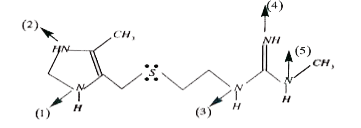C1−C2 bond is shortest inSolution in Telugu




The correct Answer is:B
Step by step video, text & image solution for C_(1)-C_(2) bond is shortest in by Chemistry experts to help you in doubts & scoring excellent marks in Class 11 exams.
Topper's Solved these Questions
- BOOK - AAKASH SERIESCHAPTER - ELECTRONIC EFFECTS AND REACTION INTERMEDIATESEXERCISE - ADDITIONAL PRACTICE EXERCISE (LEVEL - II LECTURE SHEET (ADVANCED) Straight ObjectiveType Questions)21videos
ELECTRONIC EFFECTS AND REACTION INTERMEDIATES
- BOOK - AAKASH SERIESCHAPTER - ELECTRONIC EFFECTS AND REACTION INTERMEDIATESEXERCISE - ADDITIONAL PRACTICE EXERCISE (LEVEL - II LECTURE SHEET (ADVANCED) Linked Comprehension Type Questions)3videos
ELECTRONIC EFFECTS AND REACTION INTERMEDIATES
- BOOK - AAKASH SERIESCHAPTER - ELECTRONIC EFFECTS AND REACTION INTERMEDIATESEXERCISE - PRACTICE SHEET - EXERCISE-III (LEVEL - II Integer Type Questions)8videos
ELECTRONIC EFFECTS AND REACTION INTERMEDIATES
- BOOK - AAKASH SERIESCHAPTER - ELECTRON MIGRATION EFFECTS EXERCISE - QUESTIONS FOR DESCRIPTIVE ANSWERS10videos
ELECTRON MIGRATION EFFECTS
- BOOK - AAKASH SERIESCHAPTER - ELEMENTS OF BORON FAMILYEXERCISE - OBJECTIVE EXERCISE - 37videos
ELEMENTS OF BORON FAMILY
Similar Questions
Consider the basicity of the following aromatic amines:
(I) aniline (II) p-nitroaniline (III) p-methoxyaniline (IV) p-methylaniline
The correct order of decreasing basicity is:10:32View SolutionWhen an electron withdrawing or electron releasing group is attached to carbon chain, polarity is induced on the carbon atom and on the substituent attach to it. This permanent polarity is due electron displacement due to difference in electronegativities this is called inductive effect or I effect. The inducitve effect depends in the electronegativity of the substituent. The inductive effect is broadly classified as (i) negative inductive effect or -I effect. (ii) positive inductive effect or +I effect.
The group which exhibits the maximum -I effect04:26View SolutionOn mono protonation which nitrogen of the following compound can be protonated.
 04:06View Solution
04:06View SolutionHyperconjugation effect is also termed as 'no bond resonance'. Why?
06:38View SolutionWhich one of the following compounds is not a protonic acid ?
02:44View Solution(C_(0)+C_(1))(C_(1)+C_(2))(C_(2)+C_(3))(C_(3)+C_(4)).........(C_(n-1)+C_(n))=(C_(0)C_(1)C_(2).....C_(n-1)(n+1)^(n))/(n!)
02:05View SolutionC_(0)C_(1)+C_(1)C_(2)+C_(2)C_(3)+...+C_(n-1)C_(n)
08:52View SolutionProve that (C_(0)+C_(1))(C_(1)+C_(2))(C_(2)+C_(3))(C_(n-1)+C_(n))=((n+1)^(n))/(n!)*c_(0)*C_(1)*C_(2).........
05:46View SolutionIf (1+x+x^(2))^(n)=(C_(0)+C_(1)x+C_(2)x^(2)+.........) then the value of C_(0)C_(1)-C_(1)C_(2)+C_(2)C_(3)...
02:53View SolutionIn but-1, 3-diene the C2−C3 bond length is
02:35View Solutionin C_(1)-H, C_(2)-H and C_(3)-H the homolytic bond dissociation energy order is :
02:09View Solution(C0+C1)(C1+C2)(C2+C3)....(Cn−1+Cn)=
View SolutionIf C0+C1+C2+......+Cn=128 then C0−C12+C23−C34+......=
09:24View SolutionIf C0,C1,C2,…,Cn are the binomial coefficients in the expansion of (1+x)n⋅n being even, then C0+(C0+C1)+(C0+C1+C2)+….+(C0+C1+C2+…+Cn−1) is equal to :
View SolutionWhich of the following statements are correct for butadiene
4CH2=3CH−2CH=1CH2
(1) The C1−C2andC3−C4 bonds are longer than a carbon double bond.
(2) The C1−C2andC3−C4 bonds are shorter than a carbon - carbon double bond.
(3) The C2−C3 bond is slightly shorter than a carbon - carbon single bond.
(4) The C2−C3 bond is slightly longer than a carbon - carbon double bond.03:03View SolutionC1−C4 glycosidic bond is NOT found in
02:48View Solution

